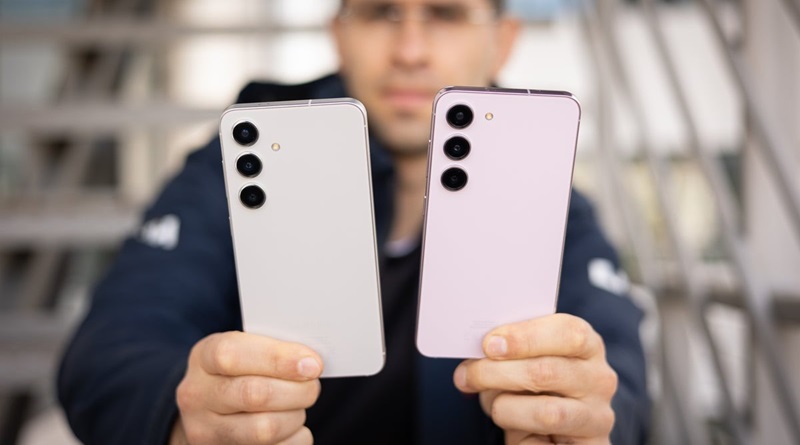Samsung Galaxy S24 vs. Samsung Galaxy S23: A Comparison
New Delhi: The Samsung Galaxy S24 introduces subtle yet significant design changes, a larger and brighter display, enhanced camera processing, and improved battery life compared to the previous S23 model. These updates aim to enhance the real-world user experience and set the S24 apart from its predecessor. Explore our editor’s evaluation below.

Display and Design:
The Galaxy S24 boasts a precise screen size of 6.17 inches (rounded to 6.2″), slightly larger than the 6.1-inch display on the S23. While both models maintain a 1080p resolution, the S24 shines with an increased peak brightness of 2,600 nits, compared to the S23’s 1,750 nits, enhancing visibility outdoors. In lab tests, the Galaxy S24 achieved a remarkable 1,345 nits maximum brightness, surpassing the 1,076 nits of its predecessor. It also offers a minimum brightness of 0.9 nits, the dimmest among mainstream phones, ideal for nighttime usage. The S24 proudly introduces a 1Hz-120Hz adaptive refresh rate, conserving power in static content scenarios. Additionally, its ultrasonic fingerprint scanner embedded in the screen delivers slightly faster performance than the S23, a practical upgrade for daily usage.
Performance and Software:
The Galaxy S24 introduces a faster chipset, but the spotlight this year is on Galaxy AI, seamlessly integrated into the new Samsung One UI 6.1 software. Key apps are empowered with AI capabilities. The native Phone app offers real-time call translation using on-device AI for enhanced privacy. The Samsung keyboard now features Chat Assist, enabling message translation and providing tone suggestions. Transcript Assist summarizes and translates voice memos during meetings. Samsung collaborates with Google, presenting Circle to Search with Google, facilitating easy search functionality. With AI breakthroughs, the Galaxy S24 delivers an elevated user experience and expanded capabilities across various applications.
Performance Benchmarks:
The Galaxy S23 will also receive the same AI features through an update, ensuring that you won’t miss out for long. The Galaxy S24 features the Snapdragon 8 Gen 3 processor in the US, while other countries have the Samsung-made Exynos 2400 chipset. It offers 8GB of RAM (LPDDR5X, same as S23), which may disappoint considering the One UI interface’s RAM requirements. In benchmark tests, the Exynos chipset outperforms the Snapdragon 8 Gen 2, particularly in gaming. However, occasional stutters were observed in the S24’s performance due to the Samsung One UI interface. Storage options include 8/128GB and 8/256GB models. Notably, the Galaxy S24 provides an impressive seven-year support for OS upgrades and security patches, surpassing the four-year support of the S23.
Camera:
The Galaxy S24 features the same camera setup as the S23, including a 50MP main camera, a 10MP 3X zoom lens, a 12MP ultra-wide lens, and a 12MP front camera. However, Samsung has made significant improvements in image processing. The S24 delivers softer and more natural-looking detail, enhancing overall image quality. Exposure and color adjustments result in fewer overexposed shots and less saturated colors, creating a more balanced and realistic look. Nighttime photography displays improved detail, although occasional inaccuracies in skies and saturation can still occur. Zoom and ultra-wide photos showcase reduced oversharpening and richer colors. Selfies also benefit from subtle enhancements in tone and quality.
Audio Quality and Haptics:
One area that has not changed much is the audio system or haptics too for that matter.
The Galaxy S23 sound quality was fine, but not quite the best out there. The loudspeakers output sound which is a bit “thin” for a flagship phone, with less deeper tonalities than we’d like to hear, and the situation has remained practically identical on the S24.
Battery Life and Charging:
With the slightly larger overall size of the phone, the Galaxy S24 gets a modest upgrade in battery size to 4,000 mAh, up from 3,900 mAh on the Galaxy S23.That’s a change of 2.5%, not enough to really make a difference.What remains the same for sure, however, are charging speeds. Using a cable, you can hit a maximum rate of 25W for charging, while wireless charging works at 15W. There is no support for the fancy Qi2 magnetic wireless charging standard on the Galaxy S24.
The Galaxy S24 is an incremental update over the Galaxy S23. It offers an updated design, slightly faster chipset, improved fingerprint scanner, brighter screen, and camera upgrades. However, the fundamentals remain largely unchanged, including battery life and charging speeds. The notable new feature, Galaxy AI, is also coming to the older S23. If you already own the S23, upgrading may not provide significant benefits. However, for those coming from older phones, the S24 offers several improvements at a reasonable price tag.





